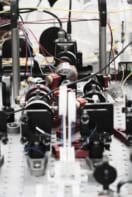Physicists in the US have built a laser with a single atom for the first time. Jeff Kimble and colleagues at the California Institute of Technology made the device by trapping a cold caesium atom in an optical cavity. The one-atom laser produces nonclassical light that could have applications in quantum information technology (J McKeever et al. 2003 Nature 425 268).

In a conventional laser an optically active material is placed between two mirrors in a cavity and then excited by an electrical current or another laser. The photons emitted by the optically active material are reflected back through the material, stimulating the emission of further photons and leading to the production of laser radiation. These lasers operate in the ‘weak-coupling’ regime, which involves large numbers of atoms and photons. This means that the quantum fluctuations of individual electrons or photons have little impact on the overall laser system.
The device built by the Caltech team is different in that the atom and the photons are strongly coupled. Kimble and colleagues start by cooling and trapping a single caesium atom in a tiny optical resonant cavity. Next a laser is used to excite the caesium atom, which then decays to an intermediate state and emits a photon. The strong coupling between the atom and cavity means that this photon is almost always emitted into a laser cavity mode rather than free space. Another laser is then used to transfer the atom to another excited state, from which it decays back to the ground state – allowing the whole processed to be repeated.
The light emitted by one-atom laser exhibits photon antibunching – a quantum effect which means that it is “quieter” or more ordered than light from conventional lasers. It also differs from conventional lasers in that there is no threshold for lasing. Although the single-atom laser has a very small flux – less than 100 000 photons per second – and only operates for about one tenth of a second, Kimble and co-workers say that their result “presses laser operation to its conceptual limit”.


